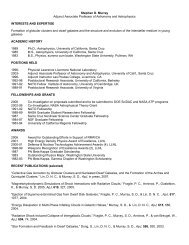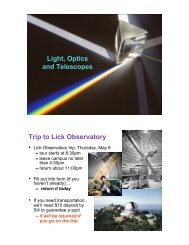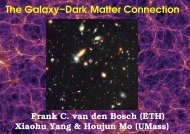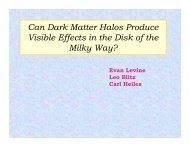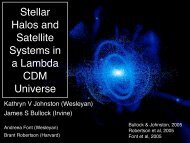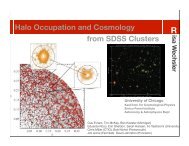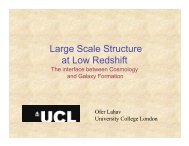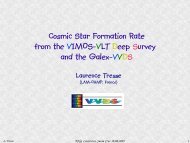UCSC Astronomy & Astrophysics Orientation Guide last update ...
UCSC Astronomy & Astrophysics Orientation Guide last update ...
UCSC Astronomy & Astrophysics Orientation Guide last update ...
Create successful ePaper yourself
Turn your PDF publications into a flip-book with our unique Google optimized e-Paper software.
dynamos) and Francis Nimmo (who is an expert on impacts within the solar<br />
system and other aspects of planetary science).<br />
DEEP http://www.ucolick.org/~deep/<br />
The Deep Extragalactic Evolutionary Probe, composed of researchers at<br />
<strong>UCSC</strong> in collaboration with researchers at Berkeley, Caltech, U. of Chicago,<br />
Hawaii, and Johns Hopkins, is a long-term Keck and HST project. The broad<br />
goals of this large-scale survey of distant, faint field galaxies include studying<br />
galaxy formation and evolution, the origin of large-scale structure, the nature<br />
and role of dark matter, and the overall geometry of the universe. Phase I of<br />
DEEP, already complete, involved Keck observations with the then-current suite<br />
of instruments, and HST observations. The current phase of DEEP employs<br />
DEIMOS, a spectrograph for Keck just constructed at Santa Cruz, and SIRTF.<br />
Members of the DEEP team at Santa Cruz include Sandy Faber, Raja<br />
Guhathakurta, David Koo, and several postdocs.<br />
GLAST http://g<strong>last</strong>.gsfc.nasa.gov<br />
The Gamma-ray Large Area Space Telescope is a future NASA mission that<br />
should launch as early as 2007. It will study high-energy astrophysical<br />
phenomena, including but not limited to neutron stars and GRBs. Steve Thorsett<br />
is an interdisciplinary scientist on the GLAST team, and several faculty in the<br />
<strong>UCSC</strong> Physics Department are also involved.<br />
HETE http://space.mit.edu/HETE/<br />
The High Energy Transient Explorer mission launched, and the project is<br />
under way. HETE's goal is to provide precise localizations of gamma-ray bursts.<br />
This will facilitate follow-up observations of the afterglows, and further our<br />
understanding of GRBs a great deal. Stan Woosley and Steve Thorsett are<br />
affiliated with the project.<br />
HST http://www.stsci.edu/<br />
Of course, one of the premier instruments of astronomy today is the Hubble<br />
Space Telescope. Harland Epps was involved in the optical design of the<br />
NICMOS instrument; Sandy Faber was on the WFC team. Garth Illingworth is<br />
affiliated with the Advanced Camera. Many (if not most) researchers at <strong>UCSC</strong><br />
work with HST data regularly.<br />
NGST http://ngst.gsfc.nasa.gov/<br />
A high priority in major astronomy funding over the next decade, the proposed<br />
Next Generation Space Telescope will be an orbiting 6-meter class<br />
telescope. It is intended to pick up where HST leaves off. Garth Illingworth has<br />
some connection to the project.<br />
SCIPP http://scipp.ucsc.edu<br />
The Santa Cruz Institute for Particle Physics is primarily concerned with<br />
accelerator experiments at SLAC and CERN but is also involved in particle and<br />
13




